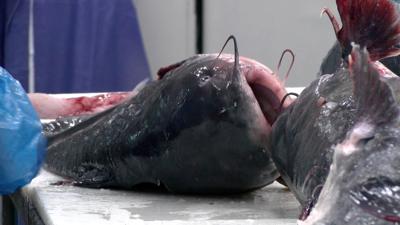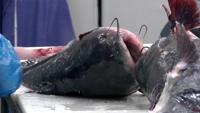SALISBURY, MD - In a two-year investigation conducted by Salisbury University researcher and professor, Dr. Noah Bressman, the invasive blue catfish has emerged as a major concern for fishermen and environmental groups in the Eastern Shore region. Termed "dumpsters of the sea" by researchers and watermen, these non-native predators exhibit a huge and rather 'just about anything' appetite, consuming a wide array of species and posing a threat to the delicate balance of local ecosystems.
Bressman, who led the first-of-its-kind study on the Eastern Shore, focused on the Nanticoke River, its tributaries, and the Marshyhope Creek. Over a thousand catfish were captured and dissected during the investigation, revealing a startling trend in their dietary habits.
"Literally the first catfish we studied—47 pounds—we pulled it out, cut open its stomach, and found a whole adult duck in its stomach, and from there it got weirder and weirder," recounted Dr. Bressman.
Contrary to the idea that these catfish will consume anything in their path, Bressman noted, "Everything's got their own preference. Just because they eat just about anything and everything that swims by them doesn't mean they don't have a preference. We can figure out what species are most of concern here." The study found that compared to other tributaries, the catfish in the Nanticoke river region are consuming a significantly higher amount of blue crabs, white perch, and threatening the already endangered river herring.
Dr. Bressman added, "What we are seeing them eating is lots of white perch, lots of river herring which are threatened, and also tons of blue crabs which is obviously problematic for Maryland."
At the Wittman Wharf Catfish Processing Plant, owned by Nick Hargrove, the findings align with their observations. "A lot of times when we open up the bellies on these fish, we see a wide range of species. The catfish is an opportunistic fish, so if it's there and he can eat it, he's going to," explained Hargrove.
Concerned about the impact on local waterways, Dr. Bressman announced plans to collaborate with the Department of Natural Resources in the coming year. Their joint project aims to target and remove the largest blue catfish, particularly the breeder fish, in an effort to mitigate the ecological threat posed by these invasive predators.
As researchers and environmentalists mobilize to address the issue, the Eastern Shore grapples with the growing presence of these formidable aquatic invaders.


